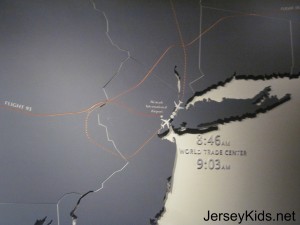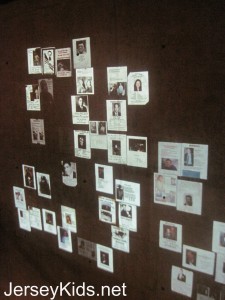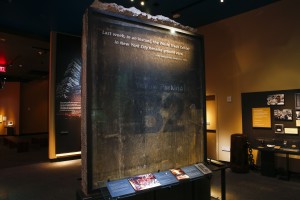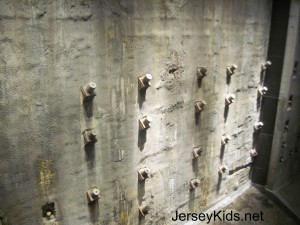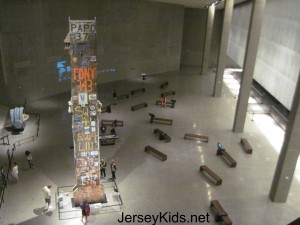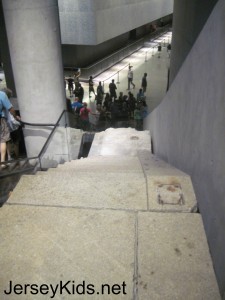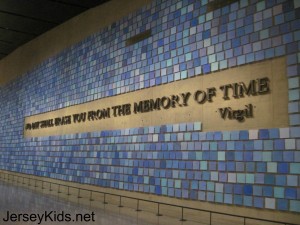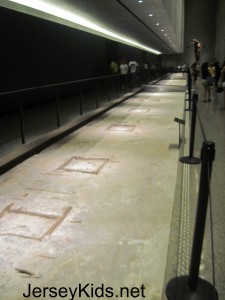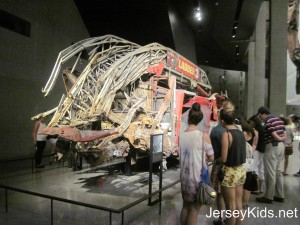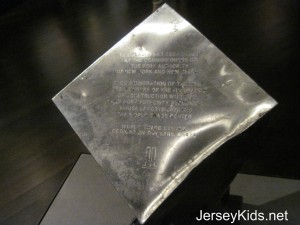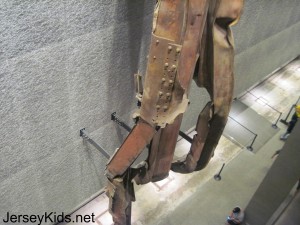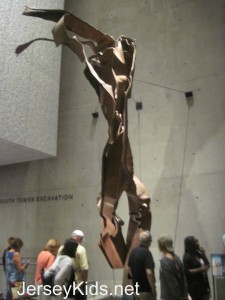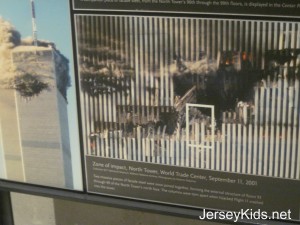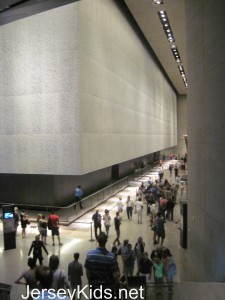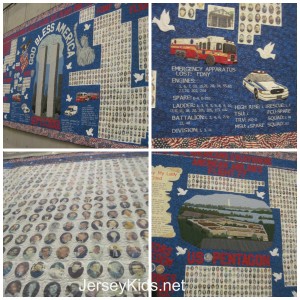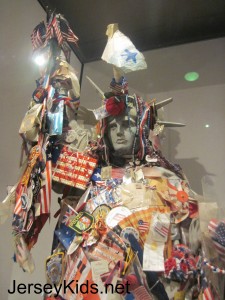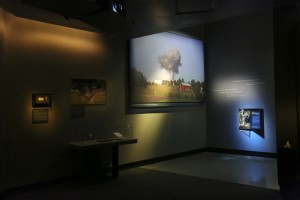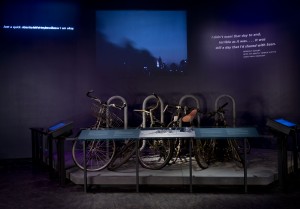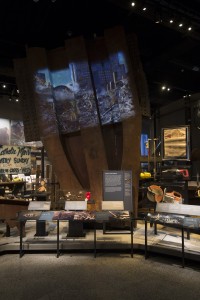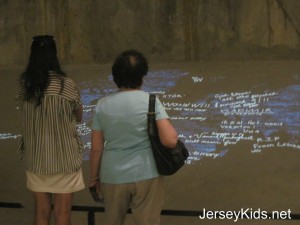This summer I went to the 9/11 Memorial and Museum. I went without my kids because I wanted to see if it was appropriate for them, and also wanted the time to go through there without the pressure of “I want to leave!” “I’m hungry!” “Are you almost done?”
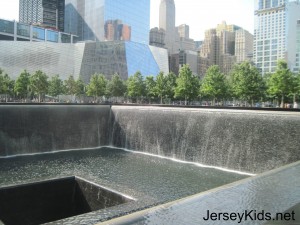
You can see the museum in the background – it’s the lower building just above the treeline on the left/center.
I’ll get into details about tickets, timing etc. at the bottom, along with age issues. I’ll also save my grand overarching thoughts about the museum for the end, so if you’re just looking for that, scroll to the bottom area. First I’d like to lead you through the museum.
9/11 Museum Entrance
When you walk into the museum (during you timed ticket time), you’ll need to go through security, much like at the airport. You’ll remove anything with metal from your pockets, and all bags (and you) are screened. Larger bags (more than 8″ x 17″ x 9″) will have to be checked. From there, you walk down the stairs (or take an elevator) to the underground space. The entire museum space is underground, underneath the plaza and tower footprints.
The information desk at the bottom of the stairs has maps and rentable audio guides for $6 in a number of languages. You can download the audio guide to your phone for free (links at the bottom) – I recommend doing it in advance to make sure it’s working. They have free wi-fi in the museum, which you’ll need. If you’re meeting a tour (sign up in advance – additional fee), you’ll meet the tour near the bottom of the steps.
At the beginning of the museum portion, you’ll see a large picture of the Wall Street area with the towers, taken just minutes before the attack. Just across from that is a large map (pictured above) showing the four flight paths that morning, along with take off time and impact time. The dotted lines are when the planes left their original flight path. I actually hadn’t looked at a map like this before, and it was powerful.
The next section had videos and photos showing the reaction of local people watching the WTC impact aftermath. It was dark and the concerned look on people’s faces might be disturbing to some kids, but it’s easy enough to walk on. There’s accompanying audio with newscasts and other voices as well.
Further down the hallway you can see images of posters placed for the missing loved ones projected on the wall. The site of the 1993 bomb blast is marked later on, which was in the B2 parking garage. Six people were killed there.
B2 Slab form 1993 WTC bombing, photo by Jin Lee, courtesy of the 9/11 Memorial MuseumYou’ll gently walk down a wooden ramp toward the rest of the museum. The ramp is new to the building, but reminiscent of the 70 foot ramp used on the site to haul debris up after the buildings came down. The underside of the ramp looks like the building’s signature trident. I didn’t hear anything about that mentioned in the signage or audio commentary, but it looked like that to me.
They have one of the original World Trade Center tourist signs from the corner of Church and Cortland (which remained in place until 2008), with details about the building before it fell.
Above you can see the slurry wall which holds the Hudson River back from flooding lower Manhattan. This wall was built in the 1950s, in preparation for the World Trade Center tower construction. The wall cracked in some areas (and you can see the newly rebuilt walls next to it), but this wall was engineered well enough to withstand the force and saved a lot of lives from potential floods.
Above you can see Foundation Hall (the slurry wall is on the left), and the last column removed from the World Trade Center site (the North Tower base is on the right). As 1.8 million tons of debris was slowly removed from the site, the top part of the column was uncovered, with lower portions exposed incrementally. Workers painted and memorialized lost ones on the column, and it was removed from the WTC site in a ceremony on May 30, 2002.
The Vesey Street staircase was preserved and you can see it above. This staircase connected a raised plaza from the building to the street. Many survivors fled down the staircase dodging debris. If you listen to the audio guide, you can hear stories told from the survivors of their experience. The staircase is partly torn up, but that’s because it was damaged in the debris removal. You will take the escalator down on the left. At the bottom you’ll see a picture of the staircase as it was, with a similar escalator next to it.
This beautiful art installation in Memorial Hall is made of individually painted pieces of paper painted with blue watercolor, by artist Spencer Finch. Each piece memorializes an individual who died on 9/11, or during the 1993 WTC bombing. The blue shades are reminiscent of the clear blue sky that morning. The Virgil quote was forged with WTC steel by blacksmith Tom Joyce. It is permanent.
The wall is shared with the Chief Medical Examiner’s office, which has been the source of controversy. A room behind there holds the remains of unidentified victims of the tragedy, and family members can visit a private space next to that room.
Surrounding each tower footprint are foundation level box column remains, flush with the ground. These were maintained to show the steel supports for each building, and reminded me a lot of an archeological dig like you’d find in Pompeii. The North tower had 84 columns, and the South tower had 73 (the train tracks crossed where the others would be). These anchored the tower down to bedrock, 70 feet down. For those interested in how towers are built, there’s a section in the museum about that. When building the WTC, they excavated more than 1 million cubic yards of earth from the inside of the slurry walls. That dirt was turned into landfill, creating 23.5 acres of which became the World Financial Center and Battery Park City.
Some of the larger artifacts at the museum bring home the sheer size of the destruction. You can see a firetruck above (and there are several other rescue vehicles in other parts of the museum that you can’t photograph). This is Ladder Company 3’s truck, and they were excavating the North tower. Debris from the falling building came down and crushed the front of the truck. Eleven firefighters from this company were inside the building when it collapsed, and none survived. You can also see the TV/radio antennae structure from the top of the North tower, and read about the men who worked there, and whose lives were lost.
Separated into two areas in the museum, you can see steel beams from the 77-85th floor and 93-96th floor, which at one point were connected. This was the impact site of the South tower from Flight 11, and if you piece them together, you can make out where the nose of the plane hit.
It almost looks like a sculpture the way it twisted. The fireproofing tore off and heat from the airline fuel melted the steel, causing the collapse. You can read more about how steel is fireproofed and what the situation was in the WTC buildings here.
In this picture above, you can see the impact site as well as the location of the steel taken from the picture just above it.
Each tower footprint has a different exhibit area below, which do not allow photographs. The concrete areas you’re looking at hold the memorial pools. Each floor of the World Trade Center towers was an acre in size.
Next to the South tower area is Tribute Walk, which does not have site artifacts (other than the steel pictured above), but rather some tributes created by people around the world. This area includes rotating pieces. The most impressive is the quilt pictured above. It is HUGE and was created by 500 people, and dedicated in 2006. It includes pictures of everyone who died in the 9/11 attack, as well as those from the WTC bombings. The people are separated out by airplane, building (including the Pentagon and those who crashed in the Pennsylvania field). It also lists rescue vehicles lost. It’s really quite something.
Lady Liberty (photo above) lived outside of of one of the firehouses after 9/11, decorated by citizens with mementos and remembrances of their loved ones. This is something the kids should definitely see. There’s a LEGO flag, pictures, patches and many other things on there. This area is also where the education center is,where kids can go to create murals from Thursdays to Saturdays (check times before you go). I couldn’t find anything about this on the website or map, but the PR person told me this would be happening.
The exhibitions under the North and South tower footprints are “no photo zones,” for good reason. The South tower has an “In Memoriam” exhibit, with pictures of everyone who died in the towers and during the WTC bombing. Mostly it’s walls of pictures, with some interactive computers where you can look up someone’s name and learn more about them. If family contributed photos or recorded stories through Story Corp, you can hear and see those as well. In the center there’s a dark room with the names read aloud, sometimes by family members who record them. The photo will accompany the person’s name, and you can sit in there and listen. The exhibit has a few personal artifacts, like keys found on the site or someone’s full wallet with receipts and credit cards.
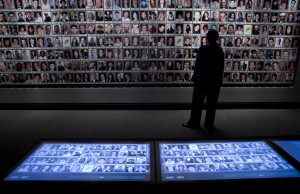
Interactive touchscreens allow you to learn more about the lives of the individuals lost in 9/11. Photo by Jin Lee, courtesy of the 9/11 Memorial Musuem
The historical exhibit in the North tower is the one that would be the hardest to take kids into. It was immense, and you’ll feel assaulted from all sides with pictures, audio and the mass of other people visiting. If you’re claustrophobic, it might be a tough place for you. It was crowded in spite of controlling ticket entries. It was also the longest, most emotionally exhausting exhibit there, and it was the last one I went into.
The exhibit is divided into three areas: the day as it unfolds (9/11), the immediate aftermath (post 9/11), and historical context (pre 9/11).
A timeline runs along the wall. You’ll see artifacts ranging from rescue vehicles and clothing, to airplane seats, windows and seat belts from the crashed planes. You’ll see a note that said “84th floor – west office – 12 people trapped.” There’s a section on the Pentagon crash as well.
Some sections have warnings outside about sensitive exhibits/displays inside. One was an alcove with a compilation/timeline of Flight 93, that crashed in Shanksville. You could hear a 7 minute presentation which includes excerpts of the original phone calls made from flight attendant Betty Ong, the hijackers in the cockpit and others. Fortunately there’s also a tissue box in the room – much needed. The room had pictures of the site and some items recovered from there. I would not take kids in there.
Another alcove with a warning showed continual photos of people jumping from the WTC, with estimates of 50-200 people jumping to their death. Again, not for kids (though I did see one mom explaining to her child about it outside there).
You’ll see video of the towers falling (it only took 10 seconds a tower), the first video to appear of the plane flying into the South tower, taken by a filmmaker in the area for something else. You’ll see the bike rack from the WTC with bikes still attached – only one person came later to claim a bike. You can hear the answering machine messages received on Mark Bingham’s (passenger on Flight 93) answering machine.
By the time I made it to the historical section on terrorism and Al Qaeda, I was wiped out and couldn’t read anything more. I was able to walk through the section on what happened just after, which includes the clean-up efforts and individual efforts to help the rescue workers, but wouldn’t mind going again – it was hard to pay full attention since I was done. You’ll see the WTC steel cross that was erected on site. You’ll see signs offering religious services, food and see a whole storefront of clothing covered in the dust.
Toward the end, I heard what sounded like bagpipe music, and I went into Foundation Hall to see a trio of bagpipe players belting out Amazing Grace and other songs. You can hear them play part of Amazing Grace in this video. It was truly beautiful. A guard told me that she didn’t know they were coming, that there wasn’t a schedule. She hadn’t heard them there before, and this was August, three months after the museum opening in May.
In addition to the last column, Foundation Hall has some interactive screens with registries on them. You can see where all the 9/11 memorials are around the world, including those that have WTC steel at them. You can see registries of the rescue and recovery workers who participated in the clean-up efforts, and registries of witnesses and survivors. If you fall into one of those categories, you can join the registry and participate. If there’s a memorial that’s not yet listed, you can add it, along with pictures.
At the end, you can write your thoughts and remembrances on a touchscreen computer, and it will be projected in the room (see picture above). There’s also a section of WTC steel you can touch. The room holds the only section of glass, from the South tower. About 40,000 windows shattered in the attack. This is the one that survived. Ironically, it’s placed behind glass.
Yes, there’s a museum store to visit as well. It garnered a lot of controversy when it opened, which surprised me because the Vesey Street store was opened for years before this, and we didn’t hear a peep of concern. You can buy t-shirts, scarves and jewelry, trinkets and books. The proceeds go to sustain the museum and memorial. I didn’t look too closely at the offerings, but didn’t see anything overtly tacky (they removed some items after the initial controversy). I have no interest drinking my coffee out of a memorial mug, but then again, I rarely buy anything at museum gift shops.
Should you go?
I had friends ask me whether it was worth a visit. I think it was, though I totally understand how those who lived through it locally wouldn’t want to visit, aren’t ready to visit, or can’t handle visiting. I wasn’t living here on 9/11, so I don’t have that same reaction. I thought the museum was done well, respectfully and reverently. It did not hold back in terms of showing some of the awful things, like people jumping out of windows. It’s not sugar coated. The mood there was somber, the rooms were relatively dark. The historical section in the North tower section seemed comprehensive and too much for me to take in at once. Was it a happy museum visit? No. But I did feel I was in a sacred space.
Taking the Kids to the 9/11 Museum
At some point I will consider taking my kids to the museum. Given that I live in the area, I have a choice of when to do that. If visiting from somewhere further away, you may have to make the decision to see it now or never. The museum recommends that kids be over age 11 to visit, and even then, some exhibits may be too much for them. I saw a number of kids younger than them there, but didn’t pay too much attention. If your kids are going to be disruptive or loud, please don’t take them. It’s not fair to the others visiting.
Here are some ways to see the 9/11 Memorial Museum with your kids.
—Download this guide, which talks about seeing the museum with your kids. It’s aimed at kids 8-11. It gives guidelines on how to discuss the events of that day, and ways to discuss some of the objects you’ll see there, like the fire truck. It gives prompting discussion questions which gets the kids to pay attention to details and think for themselves.
–Download the audio guide on your phone, tablet or iPod Touch. It’s free. They have a kids’ version included, which explains things in slightly different language to kids, and allows them (and you) to go in the order you’d like. You can rent an audio guide as well – I’m sure it also has the kids’ version.
–Go with a school group.
–The memorial and museum site has a section on talking to your kids about 9/11. Read it ahead of time. Make sure you’ve prepared your kids in advance, and that you are ready to talk to them about it when you’re there. The site offers lesson plans for all age kids, great if you’re a home schooler or want to spend extra time with your kids on it.
–They have several movies you can watch. In the South tower, there’s Rebirth at Ground Zero, which shows images/movies of the site being rebuilt from cameras that were on site since the start, and takes about 7 minutes. You may have to wait in line to see it (I waited about 20 minutes). Upstairs in the atrium terrace, there’s another film (about 20 minutes I think) about historical figures – I didn’t see it.
–Take breaks as needed. I spent almost 4 hours in the museum, but I can guarantee my kids would not have lasted half that time. I was told that the average visit is about 3 hours. The museum has a cafe, in case you get hungry.
–The excavation section has some interesting facts about the WTC towers, including size, number of floors, number of people working there, how far it swayed side to side in wind (12 inches), and other stats. The kids might like reading about that. Future engineers might like to read about the technology behind building these skyscrapers.
–Spend some time in Foundation Hall, where there’s steel they can touch, registries they can look through. The museum has a number of touch screen and listening devices that kids may capture the kids’ attention more than reading panels.
–If there on a Thursday through Saturday, find out if there are activities in the education area, where the kids can create art.
–Consider just visiting the 9/11 memorial – you can see pictures and information about it here. The memorial contains the pools/fountains in the footprint of the two World Trade Center towers. You can see the names of those lost in the attacks and walk around the area and talk about what happened. For some families, this is a better option than going into the museum.

The tridents were the hallmark feature of the World Trade Center building. Here two are on display when you enter, from the North tower.
Tickets: Get your tickets in advance if possible, since they’re timed. This will save you waiting time. Tickets are $24/adult, $18/senior, college student, veteran, $15/kids under 7-17. Free under age 6, but I don’t recommend you take them. Tickets are free for FDNY/NYPD/PAPD, rescue workers, families, military (active/retired) and members. Admission is free Tuesdays from 5 to closing, last entrance at 7. Due to demand, try to reserve in advance.
Tours: Bring a headset to make listening more comfortable, and less disturbing to others. Guided tours are one hour long, aimed at adult and teenage visitors. Book in advance. Plan on paying double for admission if it includes the tour.
You can visit the memorial (pools/fountains in the towers’ footprints) without tickets or timing. See more about the 9/11 memorial here.
Thank you to the 9/11 Memorial Museum for providing me with review tickets. As always, all opinions are my own.
